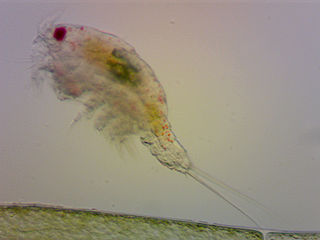Aglaodiaptomus is a genus of copepods in the family Diaptomidae. They are often bright red or blue due to carotenoid pigments.

Attheyella is a genus of copepods in the family Canthocamptidae, containing the following species:
Boeckella is a genus of copepods in the family Centropagidae.
Calamoecia is a genus of copepods in the family Centropagidae confined to Australasia. It is thought to have evolved since the separation of the Australian continent from Antarctica. Three of the Australian endemic species are listed as vulnerable species on the IUCN Red List. The genus contains the following species:
Elaphoidella is a genus of freshwater copepods in the family Canthocamptidae. It contains over 200 species, including three classified as vulnerable species by the IUCN – three endemic to Slovenia and one endemic to the United States. In total, the genus Elaphoidella contains the following species:
Fibulacamptus is an Australian endemic genus of crustacean in the family Canthocamptidae. Two of the four species are listed as vulnerable species on the IUCN Red List :
Hesperodiaptomus is a genus of copepods in the family Diaptomidae, containing 18 species. Two species – Hesperodiaptomus augustaensis and Hesperodiaptomus californiensis – are endemic to the United States and listed as vulnerable species on the IUCN Red List.
Mastigodiaptomus is a genus of Neotropical copepods in the family Diaptomidae. Two of the eight species in the genus are listed as Data Deficient (DD) on the IUCN Red List, and one is listed as a vulnerable species (VU):
Metacyclops is a genus of copepod crustaceans in the family Cyclopidae, containing 61 species, of which three are listed on the IUCN Red List – M. campestris from Brazil, M. gasparoi from Italy (vulnerable) and M. postojnae from Slovenia (vulnerable).
Muscocyclops is a genus of copepod crustaceans in the family Cyclopidae, comprising three species found only in South America. Two of the species – Muscocyclops bidentatus Reid, 1987 and Muscocyclops therasiae Reid, 1987 – are endemic to the Distrito Federal in Brazil, and are listed as conservation dependent on the IUCN Red List. The third species is Muscocyclops operculatus.
Neutrodiaptomus is a genus of copepods in the family Diaptomidae. The Japanese endemic species N. formosus is listed as Data Deficient on the IUCN Red List. The genus Neutrodiaptomus contains the following species:
Nitocrella is a genus of copepod. Although most other genera in the family Ameiridae are marine, species of Nitocrella are almost exclusively found in subterranean fresh water or brackish water. More than 80 species are included in the genus, including two which are listed as vulnerable species on the IUCN Red List:
Notodiaptomus is a genus of copepods in the family Diaptomidae. It is the most widely distributed, most abundant and most species-rich genus of freshwater calanoid copepods in the Neotropics. The genus was erected in 1936 by Friedrich Kiefer for eleven species formerly placed in a wider Diaptomus. Notodiaptomus deitersi was chosen to be the type species by Raúl Adolfo Ringuelet in 1958.
Phyllodiaptomus is a genus of crustacean in the family Diaptomidae. It includes the following species:
Skistodiaptomus is a genus of freshwater copepods in the family Diaptomidae, found across North America. The genus contains eight species, three of which are endemic to the United States and are listed on the IUCN Red List as vulnerable species (VU) or Data Deficient (DD).

Canthocamptidae is a family of copepods. Most of the 700 species are confined to fresh water, although there are also marine species. It contains the following genera:
Robert Gurney was a British zoologist from the Gurney family, most famous for his monographs on British Freshwater Copepoda (1931–1933) and the Larvae of Decapod Crustacea (1942). He was not affiliated with any institution, but worked at home, initially in Norfolk, and later near Oxford. He travelled to North Africa and Bermuda, and received material from other foreign expeditions, including the Terra Nova Expedition (1910–1913) and the Discovery Investigations of the 1920s and 1930s.
Karllangia is a genus of marine copepods. Its name commemorates the Swedish carcinologist Karl Georg Herman Lang. The genus contains five species:
Robertgurneya is a genus of copepods, containing the following species:
Darcythompsoniidae is a family of copepods, containing four genera. Members of the family have a very wide distribution throughout the tropics, where they live in rotting mangrove leaves. They lack egg sacs and are thought to lay their eggs directly into the leaf litter.

